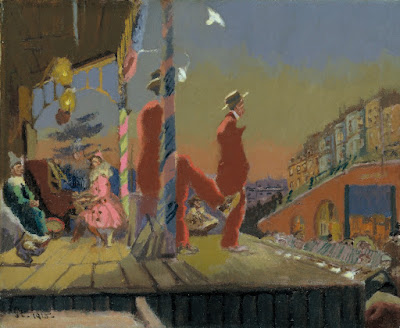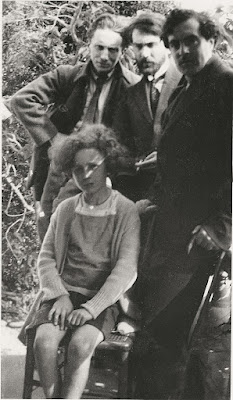WALTER SICKERT at the TATE BRITAIN on TUESDAY 26th April 2022
WALTER SICKERT at the TATE BRITAIN on TUESDAY 26th April 2022
 |
| Brighton Pierrots by Walter Sickert, 1915 |
Walter Sickert was born
in Munich in 1860 and eight years later travelled with his family to
London. His father was also an artist,
indeed Sickert began his career by imitating his father’s work. Sickert initially trained as an actor, indeed
fascination with the theatre is in evidence throughout his career. Sickert trained at the Slade School of Fine
Art before working as an assistant to established artist James Abbott McNeill
Whistler (1834-1903) in 1882.
%20Bridgeman%20images.JPG) |
| Walter Sickert, Self-Portrait 1896 |
Sickert adopted
Whistler’s signature style of muted tones and dull, realist colours. However, by 1885 Sickert had met French
artist Edgar Degas (1834-1917). He began
to follow Degas’s meticulous preparation which included a planning grid and
bolder use of colour. This can be
observed in works like Shop Front, The Laundry (1885, pencil, pen, and
ink on paper) and The Red Shop (or the October Sun) c1888, oil paint on
panel.
%20c.1888%20Norwich%20Castle%20Museum%20&%20Art%20Gallery,%20Norfolk%20Museums%20Service.jpg) |
| The Red Shop by Walter Sickert |
Sickert’s most productive
period came when the influence of Degas led him to depict music halls, but also
circuses, outdoor vaudeville acts, and cinemas which were beginning to replace
the music hall from the early Twentieth century onwards. At the time Sickert’s critics firmly believed
that popular entertainment was an unsuitable subject for fine art but in works
like The New Bedford (1907-9, oil and tempera paint on canvas) Sickert
charts the rise of music hall entertainment near his home in Mornington
Crescent, London. Sickert is believed to
have painted the first depiction of a film screening in 1906 in Gallery of
the Old Mogul (oil on canvas) the Old Mogul being the original name of the
Middlesex Music Hall near Drury Lane.
 |
| Gallery of the Old Bedford, 1894-5 |
To enhance his reputation
and obtain a regular income which somehow eluded him, Sickert attempted to
become a society portraitist. However,
he had no commissions, so the work never benefitted him financially. Notable is his portrait of Aubrey Beardsley
(1894), editor of The Yellow Book, a notorious fin de siècle
journal. Beardsley is depicted crossing
Hampstead Heath on the way to a celebration of the life of John Keats who, like
Beardsley himself, died of tuberculosis.
Sickert is utilising impressionist and post-impressionist techniques and
the pointillist style pioneered by Georges Seurat.
 |
| Little Dot Hetherington at the Bedford Music Hall by Walter Sickert, 1888-1889 |
Sickert also travelled to
the continent to paint and lived in Dieppe from 1898 to 1905 where he completed
many studies of light at different times of day at the church of St
Jacques. He was inspired by the work of
Claude Monet and his study of effets at Rouen Cathedral and by the
paintings of Dieppe completed by another leading Impressionist, Camille
Pisarro. From 1895 onwards he travelled
many times to Venice, a mecca for artists, to paint typical scenes such as the
Grand Canal, the Doge’s Palace, and St Marks.
Sickert’s close association with French art extended to include an
appreciation of fauvism and the Nabis group of artists. He depicted the urban environment and began
to complete bigger paintings of street scenes with more vivid use of colour, a
transition which was encouraged by his French dealers.
 |
| Horses of St Marks by Walter Sickert, 1901-06 |
Sickert is said to have
re-invigorated painting of the nude in Britain.
His nudes were inspired by the work of Pierre Bonnard (1867-1947) and
Edgar Degas who wanted to modernise the nude by painting it in urban
settings. French critics applauded
Sickert’s nudes, but British critics objected to Sickert’s subjects, working
class women in contemporary settings. Of
course, the implication of poverty and prostitution upset British critics who
preferred to turn a blind eye to such things, whereas the continental attitude
was much more radical and transparent.
Sickert’s nudes influenced modern British artists like Lucien Freud
(1922-2011) and Francis Bacon (1909-1992), but they have also been criticised
in terms of objectification of the male gaze by feminist art critics.
 |
| La Hollandaise by Walter Sickert, c.1906 |
The exhibition also
handles the issue of Sickert as Jack the Ripper head on in terms of his set of
paintings and preparatory sketches for The Camden Town Murder (1908). This work concerns the murder of Emily
Dimmock, a prostitute, in Camden Town in 1907, years after the Ripper
killings. The theory of Sickert as the
Ripper was conceived in 1976 by Stephen Knight in his book Jack the Ripper:
the Final Solution and then by American crime fiction writer Patricia
Cornwell in her 2002 book Portrait of a killer: Jack the Ripper – case
closed from suggestions in his paintings of low life scenes of prostitutes
and possibly rape and murder but also so-called “expert” testimony that have
been exposed as sham and concoctions.
However, Cornwell has no evidence that Sickert was the Ripper. At the time of the five Whitechapel murders
Sickert was a suspect, but he had an alibi, being in France while four of the
murders were committed. There is a
suggestion that the writing paper Sickert used was the same as the paper that
some of Jack’s letters to the police were written on, but these have long been
suspected to have been hoaxes except for the ’From Hell’ letter sent to George
Lusk of the Whitechapel Vigilance Committee in October 1888. There is still no evidence to connect Sickert
to the murders and Cornwell’s allegation seem to stem from the same kind of
objection to Sickert’s paintings made by contemporary critics, that subjects like
working class women are no subject for fine art. If so, Cornwell has deduced, there must be
some other reason, but this is highly unlikely.
Sickert was a progressive figure in the art world dealing with working
class culture in a highly original way.
There’s no suggestion that there’s anything more to Sickert than the
work of an artist exploring something new, a task that every artist should feel
duty bound to do. Also, Sickert is
hardly in position to sue Cornwell for libel, is he?
 |
| L'Hotel Royale Dieppe by Walter Richard Sickert 1894 |
Nevertheless, Sickert was
undoubtedly fascinated by the Ripper’s murders and completed a painting
entitled Jack the Ripper’s Bedroom (1905-7) based on his belief that he
had lodged in a room previously occupied by the Ripper. Sickert’s landlady believed that the previous
occupier who lodged there in 1881 was none other than the Ripper. Sickert was fascinated by crime, mystery and
once said ‘murder is as good a theme as any other.’
 |
| Ennui by Walter Sickert, 1914 |
Sickert began to
incorporate photography and photographic technology into his painting. The exhibition includes a camera lucida
instrument which Sickert used to scale up photographs onto large canvases. In the 1920s and 1930s he began painting
large scale works from press-cuttings.
These were brighter and bolder works, depicting major Royals, members of
the aristocracy, celebrities like Amelia Earhart whose solo flight he captured
from a news photograph in May 1932. He
also painted his favourite actresses such as Peggy Ashcroft and Gwen
Ffrangcon-Davies. His use of photography
anticipates later developments in abstract expressionism and pop art.
Tate Britain’s new
exhibition Walter Sickert is a must-see event that tells us much of what we
need to know about the evolution of popular and populist art in Britain over
the last 150 years. It is fascinating
but the object of interest are Sickert’s paintings, not the irrelevant tittle
tattle surrounding him.
Paul Murphy, Tate
Britain, April 2022
.%20Purchased%20in%201938%20with%20income%20from%20the%20Macdonald%20Bequest.jpg) |
| Pimlico by Walter Sickert c 1937 |

Comments